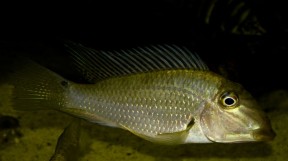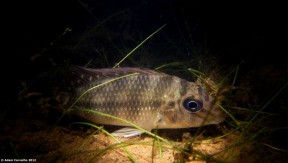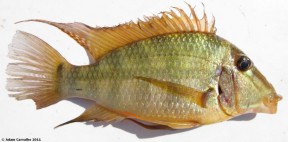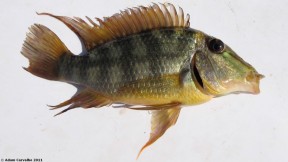Satanoperca jurupari
Demon Eartheater
SynonymsTop ↑
Geophagus jurupari Heckel, 1840
Etymology
Satanoperca: from the Ancient Greek Σατάν (Satán), meaning ‘Satan’ (the devil), and πέρκη (pérkē), meaning ‘perch’.
jurupari: derived from jurupari pindi, a vernacular Tupi term for this species which translates as ‘devil’s fish hook’. The word jurupari means ‘demon’ in Tupi, and is used to refer to a particular malignant spirit which lurks in the forest and is feared by the indigenous people.
Classification
Order: Perciformes Family: Cichlidae
Distribution
Recorded throughout much of the Amazon river basin in Brazil, Bolivia, Peru, Ecuador, and Colombia (and possibly the Orinoco watershed in Colombia and Venezuela; see ‘Notes’), but genetic research suggests that downstream of the rio Madeira it may be restricted to the Amazon main channel and lower reaches of affluents, while upstream it occurs in the Amazon/Solimões and throughout other tributary systems including the rios Negro, Purus, Japurá, Juruá, Putomayo, Javary, Napo, Marañón, Huallaga, and Ucayali.
Populations formerly referred to S. jurupari from the rios Tapajós, Xingu, Araguaia, and Paraná (the latter may have been artificially introduced) do not appear to be conspecific.
It has also been recorded in smaller coastal river drainages north of the Amazon’s mouth, such as the rio Araguari in Amapá state, northeastern Brazil, and several watersheds in French Guiana, but these populations display certain morphological differences when compared with Amazonian fish and are possibly distinct (see ‘Notes’).
Type locality is ‘Mouth of Rio Negro in Amazon River, Brazil’.
Habitat
Has been observed in main river channels, smaller tributaries and floodplain lakes, typically over substrates of sand or mud with patches of leaf litter and submerged tree branches.
Maximum Standard Length
150 – 185 mm.
Aquarium SizeTop ↑
An aquarium with a base measuring at least 210 ∗ 60 cm or equivalent is required.
Maintenance
The most essential item of décor is a soft, sandy substrate so that the fish can browse naturally (see ‘Diet’).
Coarser materials such as gravel or small pebbles can inhibit feeding, damage gill filaments and even be ingested with the potential of internal damage or blockages.
Additional furnishings are as much a case of personal taste as anything else but the most favoured set-ups tend to feature relatively dim lighting plus some chunks of driftwood and scattered roots or branches.
Leaf litter is a typical feature of the natural environment but not really recommended in aquaria because the feeding behaviour of Satanoperca spp. tends to cause an excess of partially-decomposed material in suspension which not only looks unsightly but can block filter and pump mechanisms.
Water quality is of the utmost importance since these cichlids are extremely susceptible to deteriorating water quality and swings in chemical parameters so should never be introduced to a biologically immature aquarium. S. daemon also requires soft, acidic conditions and in most cases will not thrive in untreated tap water.
The best way to achieve the desired stability is to filter the tank using a combination of external canister filters and/or a sump system and perform minimum weekly water changes of 50-70%.
If the maintenance regime is insufficient health issues such as head and lateral line erosion or stunted growth can occur.
Mechanical filtration should also be tailored to trap small particles stirred up by the fish as sand can cause blockages and wearing issues with filter mechanisms if allowed to continually run through the system. High flow rates should be avoided so position filter returns accordingly.
Water Conditions
Temperature: 20 – 28 °C
pH: 5.5 – 7.5
Hardness: 36 – 215 ppm
Diet
Satanoperca spp. are benthophagous by nature, employing a method of feeding whereby mouthfuls of substrate are taken and sifted for edible items with the remaining material expelled via the gill openings and mouth. For this reason they are commonly termed ‘eartheaters’ and the provision of a suitable substrate is essential to their long-term well-being. Once settled they readily rise into the water column when food is introduced but continue to browse normally at other times.
The stomach contents of wild specimens mostly comprise small aquatic and terrestrial invertebrates including cladocerans, ostracods, and insect larvae (particularly chironomids), plus plant material (seeds), organic detritus and sediment.
Even large individuals seem unable to properly ingest larger food items, meaning the diet should contain a variety of high quality, fine-grade prepared foods plus small live or frozen bloodworm, Tubifex, Artemia, mosquito larvae, etc. At least some of the dried products should contain a high proportion of vegetable matter such as Spirulina or similar.
Home-made, gelatine-bound recipes containing a mixture of dried fish food, puréed shellfish, fresh fruit and vegetables, for example, are proven to work well and can be cut into bite-sized discs using the end of a sharp pipette or small knife.
Rather than a single large meal offer 3-4 smaller portions daily to allow natural browsing behaviour as this seems to result in the best growth rate and condition.
Behaviour and CompatibilityTop ↑
Unless breeding this species is surprisingly peaceful and will not predate on fishes larger than a few millimetres in length. Suitable tankmates are numerous and include most peaceful species enjoying similar environmental conditions. Best avoided are aggressive or territorial substrate-dwelling species, or those requiring less acidic or mineral-rich water.
Some aquarists keep Satanoperca spp. alongside freshwater stingrays of the genus Potamotrygon which in many cases has proven successful but in some has resulted in the cichlids disappearing at night.
S. jurupari is gregarious and tends to exist in loose aggregations unless spawning, with juveniles in particular displaying strong grouping instincts. A group of 5-8 individuals should be the minimum purchase and these will form a noticeable dominance hierarchy. When maintained in smaller numbers weaker specimens can become the target of excessive antagonism by dominant individuals or the group may fail to settle and behave nervously.
Sexual Dimorphism
Adult females tend to grow slightly smaller than males and are deeper-bodied when gravid.
Reproduction
This species is an ovophilous maternal mouthbrooder that has been bred in aquaria. There does not appear to be any particular trigger for the spawning process with the main requirements being good diet and stringent maintenance regime involving relatively large weekly water changes.
Since accurate sexing is very difficult it is perhaps best to begin with a group of young fish and allow pairs to form naturally, while a degree of patience is also required since it can be at least a year, often two or more, until they become sexually mature.
Courtship is initiated by the male, with nuptial individuals forming territories which are typically centred around a piece of driftwood or other solid object. Gravid females are courted and when a pair forms they may defend the territory together for a few days prior to spawning. Other fishes, especially conspecifics, are not tolerated in the vicinity and in smaller aquaria may need to be removed.
Eggs are deposited in small batches and once fertilised immediately collected by the female, the process normally being repeated until she is carrying several hundred. In some cases the male may also pick up some eggs but does not usually hold them for long, and the female is normally ejected from the territory soon after spawning is complete although apparently some males do display extended brood care behaviour.
Once the fry are free swimming they are easily-fed, accepting good quality powdered dry foods, Artemia nauplii, microworm, etc.
If maintaining the adults in a community situation it is recommended to remove brooding females since the fry become easy prey for other fishes, including conspecifics, once released.
NotesTop ↑
S. jurupari is also known as ‘demon fish’, ‘jurupari earth eater’, ‘green horse face’, or simply ‘jurupari’ in the aquarium hobby.
It can be distinguished from other members of the genus by the following combination of characters: presence of a relatively small dark ocellus on the upper caudal-fin base; absence of well-defined dark blotches on the sides of the body (although some forms do display dark markings on the body when stressed or sleeping); absence of small or large white spots on the sides of the head (although some populations may have iridescent spots on the head, these fade in preserved specimens); absence of black spots at the base of the dorsal-fin; absence of a dark lateral stripe on the body.
In aquarium literature it is frequently confused with S. leucosticta, but that species has prominent white spots or vermiform markings on the sides of the head and is more common in the ornamental trade since it is farmed on a commercial basis in several countries.
Among the described species S. jurupari is most similar to S. rhynchitis Kullander 2012 but can be distinguished by possession of: a modal dorsal-fin count of XV.10 (vs. XV.9); 27 (vs. 26) scales in the E1 row above the lateral line; 14-18, usually 16-17 gill rakers (vs. 13-15, usually 13-14); gill blade wider (vs. narrower) than ceratobranchial; snout generally shorter, measuring 11.3-15.9 % SL (vs. generally longer, 14.3-19.4 % SL).
The precise identity of S. jurupari is a confusing issue, however, with differences in colour pattern and morphological characters observed across its range. Recent phylogenetic research has demonstrated that populations from the rios Tapajós, Xingu, Araguaia, and Paraná are genetically distinct from those inhabiting the western Amazon region. Those from the Tapajós and Xingu appear to be geographically endemic, while the Araguaia and Paraná fish are closely related, and all three lineages may represent distinct species.
S. rhynchitis is a form from the Oiapoque, Approuague, Kourou, Comté, Iracoubo, and Sinnamary rivers in French Guiana which was previously referred to S. jurupari and known as S. sp. ‘red lips’ in the ornamental trade. A similar red-lipped form also occurs to the immediate south in Amapá state, northeastern Brazil, but specimens from the rio Araguari in Amapá were not recovered as genetically distinct from S. jurupari in phylogenetic analyses, and in morphological terms they appear intermediate between S. jurupari and S. rhynchitis.
It is still unclear whether these intermediate fish (1) are natural hybrids between S. jurupari and S. rhynchitis, (2) represent a distinct species themselves, (3) signify a clinal gradient of variation between populations from Amapá and French Guiana, or (4) S. rhynchitis is a rheophilic phenotype of a more widespread species.
There is also a possibility that populations from the Río Orinoco watershed in Colombia and Venezuela, currently referred to as S. mapiritensis (Fernández-Yépez 1950), may turn out to be conspecific with S. jurupari. There appears to be no clear genetic separation between these two putative species nor a form known to aquarists as S. sp. ‘Negro-Alto Orinoco’. It is also worth noting that both S. mapiritensis and a form from the Río Madre de Dios watershed in Peru both have orange-coloured lips as adults.
Based on current knowledge, it thus remains impossible to deduce whether the group of putative species currently comprising S. jurupari, S. mapiritensis, and S. rhynchitis, plus populations from Amapá and the upper Negro/upper Orinoco region, represent distinct taxa or a single meta-population which can be referred to as S. jurupari sensu lato. Here on SF we include the named species separately, since they continue to be considered valid.
Satanoperca was considered a synonym of Geophagus for a number of decades before being revalidated by Kullander (1986). It is separated from all other members of the putative cichlid subfamily Geophaginae by presence of a small ocellated spot at the upper caudal-fin base, and from Geophagus by a number of morphological characters as follows: equal numbers of abdominal and caudal vertebrae or one more abdominal vertebra (vs. more caudal than abdominal vertebrae in Geophagus); no ribs on caudal vertebrae and no postabdominal swimbladder extensions (vs. presence of both in Geophagus; cheek scaled rostrally to centre (vs. naked on anterior half; dorsal and anal fins naked (vs. scaled); external gill rakers on lower limb of first gill arch attached to the skin covering the gill filaments (vs. attached to ceratobranchial skin); jaw dentition reduced to one or two short series in each jaw (vs. pluriseriate with wide band of inner teeth); absence (vs. presence) of tooth plates on 4th ceratobranchial; presence (vs. absence) of an ocellus on caudal-fin base; both or only upper lip fold continuous (vs. both interrupted anteriorly); preoperculum and supracleithrum frequently serrated (vs. entire); absence (vs. presence) of median hypural cartilage; 3 (vs. 4) infraorbitals.
The genus is likely to contain additional species, and has been separated into three groups with distinctive morphology, namely the S. jurupari group, the S. daemon group, and the monotypic S. acuticeps group.
Among these, members of the S. jurupari group are characterised by a colour pattern comprising a dark lateral stripe or row of blotches along the side of the body, normally XV.10 (XIV-XVII.8-11) dorsal-fin rays, normally 27 (26-28) E1 scales (the longitudinal row immediately above the lower lateral line, excluding the pectoral girdle), and 12-18 rakers on the first gill arch.
S. daemon group members grow larger than other congeners, possess one or two large dark blotches on the side of the body and a prominent ocellus at the upper caudal-fin base, usually XIX.13 (XII-XIV.12-14) dorsal-fin rays, 29-31 E1 scales, and 18-22 gill rakers. S. acuticeps is unique in that it has a relatively more terminal mouth than all other genus members, normally XIII.12 (XIII.11-12) dorsal-fin rays, 27-28 E1 scales, and 17-20 gill rakers.
The groups also differ in reproductive strategy, with the S. daemon and S. acuticeps assemblages being substrate spawners, and the S. jurupari group mouthbrooders.
Satanoperca and a number of related genera are often included in the putative subfamily Geophaginae, and Kullander (1998) conducted a morphology-based phylogenetic study in which the neotropical Cichlidae was divided into six subfamilies of which the Geophaginae contained 16 genera divided among three ‘tribes’:
Acarichthyini – Acarichthys and Guianacara.
Crenicaratini – Biotoecus, Crenicara, Dicrossus and Mazarunia.
Geophagini – Geophagus, Mikrogeophagus, ‘Geophagus‘ brasiliensis group, ‘Geophagus‘ steindachneri group, Gymnogeophagus, Satanoperca, Biotodoma, Apistogramma, Apistogrammoides and Taeniacara.
Later molecular studies by Farias et al. (1999, 2000, 2001) resulted in the additions of Crenicichla and Teleocichla to the Geophaginae, a result supported by López-Fernández et al. (2005) who conducted the most detailed molecular analysis of the grouping to date including 16 of the 18 genera and 30 species.
However their conclusions regarding interrelationships between genera did vary somewhat from previous hypotheses and can be summarised by the following loosely-defined groups:
– a weakly-supported sister group relationship between Acarichthys and Guianacara.
– a well-supported ‘Satanoperca clade’ comprising Satanoperca, Apistogramma, Apistogrammoides and Taeniacara.
– a ‘big clade’ with Geophagus, Mikrogeophagus, ‘Geophagus‘ brasiliensis group, ‘Geophagus‘ steindachneri group, Gymnogeophagus, Biotodoma, Crenicara and Dicrossus.
– a ‘crenicarine clade’ with Biotoecus and Crenicichla.
No representatives of Teleocichla or Mazarunia were included in the study but the former is well-established as sister to Crenicichla while the latter has grouped closely with Dicrossus and Crenicara in earlier works.
The other main conclusions of the paper are confirmation that Geophaginae is a monophyletic group exhibiting strong signs of having undergone rapid adaptive radiation.
References
- Heckel, J. J., 1840 - Annalen des Wiener Museums der Naturgeschichte v. 2: 325-471
Johann Natterer's neue Flussfische Brasilien's nach den Beobachtungen und Mittheilungen des Entdeckers beschrieben (Erste Abtheilung, Die Labroiden). - Gosse, J.-P., 1976 - Académie Royal des Sciences d'Outre-Mer, Cl. Sci. Nat. Méd. (N. S.) 19(3): 1-173
Révision du genre Geophagus (Pisces Cichlidae). - Kullander, S. O., 2012 - Cybium 36(1): 247-262
A taxonomic review of Satanoperca (Teleostei: Cichlidae) from French Guiana, South America, with description of a new species. - Kullander, S. O., 1986 - Swedish Museum of Natural History: 1-431
Cichlid fishes of the Amazon River drainage of Peru. - Kullander, S. O., 1998 - EDIPUCRS, Porto Alegre: 461-498
A phylogeny and classification of the South American Cichlidae (Teleostei: Perciformes). In: Malabarba, L. R. , R. E. Reis, R. P. Vari, Z. M. S. de Lucena and C. A. S. Lucena (eds). Phylogeny and classification of Neotropical fishes. - Kullander, S. O. and E. J. G. Ferreira, 1988 - Cybium 12(4): 343-355
A new Satanoperca species (Teleostei, Cichlidae) from the Amazon River basin in Brazil. - López-Fernández, H., R. L. Honeycutt, and K. O. Winemiller, 2005 - Molecular Phylogenetics and Evolution 34(1): 227-244
Molecular phylogeny and evidence for an adaptive radiation of geophagine cichlids from South America (Perciformes: Labroidei). - Reis, R. E., S. O. Kullander and C. J. Ferraris, Jr. (eds), 2003 - EDIPUCRS, Porto Alegre: i-xi + 1-729
Check list of the freshwater fishes of South and Central America. CLOFFSCA. - Willis S. C., H. López-Fernández, C. G. Montaña, I. P. Farias, and G. Ortí, 2012 - Molecular Phylogenetics and Evolution 63(3): 798-808
Species-level phylogeny of ‘Satan’s perches’ based on discordant gene trees (Teleostei: Cichlidae: Satanoperca Günther 1862).








